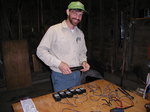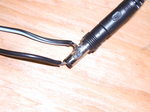I am Colin Venner, Biology major from Denison University. Orignially of Saline, Michigan (just outside of Ann Arbor), I am in the class of 2009 and I am a Taurus (though I don’t fit the profile for one). I enjoy several different styles of music and have been known to “cut a mean rug”. When I’m not counting anthers of flowering Echinacea heads you can find me enjoying life and smiling frequently.
|
||||
CategoriesExperiments
|
Colin Venner | June 29th, 2007 | Category: team member profiles | Leave a comment Hi i’m Amy Alstad. I’m 5′ 113/4″. The saddest part of life is that i’m not 6′ tall. I’m from MN and i’m going to be a junior at Carleton college Amy Alstad | June 29th, 2007 | Category: team member profiles | Leave a comment My name is Julie Nicol. I graduated from Carleton College (Northfield, MN) with a degree in biology in 2007. I am from Seattle, WA and hope to move back at some point. In the meantime I’m here working on the Echinacea project. I really enjoy the area; it’s quite beautiful. In the fall I’ll be heading to Chicago to work for Stuart at the Chicago Botanic Garden until next spring. Eventually I will (most likely) go to grad school, but I intend to spend the next few years figuring out exactly what I want to study. On a more personal note, I enjoy being outside (hiking, kayaking, diving, windsurfing, etc.), reading (one of my favorite books is The Master and Margarita), and music (I have wide-ranging tastes from joy division to dar williams). I am also interested in and concerned with social justice and environmental issues. Julie Nichol | June 29th, 2007 | Category: team member profiles | One comment Well, here are some pics from our night of terror in the barn. Stuart about to void the warranty on the camcorders Josh trying to hack the transformer Closeup of soldering job Well, I got to the farmhouse early to get ready for videorecording. Put the tripods in the big blue tubs for easy transport to the common garden, and then worked on getting random assignments of plants, which were kindly printed out by Stuart. After assigning plants to different cameras, Colin and I walked briskly to the CG to set up everything. It took much longer than expected, partly because it was the first time and partly because I am really slow. I’m not sure why — I like to be careful and I have always been the slow one in the field, oh well. One camera did not work after plugging in the doctored battery, so we pondered over it for quite a while. What was more alarming was that even the Sony-supplied battery stopped working in that particular recorder! I was worried at that point, so we tried another Sony battery and camcorder along with the doctored battery and the same horrible thing happened again — no recording and the original battery stopped working! So, we hightailed it back to the farmhouse to figure things out. After trying different combos of batteries, doctored connectors, and such, we determined that one of the doctored batteries was to blame. Either it wasn’t charged enough, or maybe too much — I will have to check with the voltmeter to find out for sure. It was a relief to know that nothing was permanently damaged — I am nervous about this whole enterprise as it has been quite expensive! But, I am hoping that the data will be worth it. Andy Andy McCall | June 29th, 2007 | Category: Pollinator Videos 2007, stories from the field | Leave a comment With a contraption built to take accurate pictures of flowering Echinacea heads, I assumed that fluctuating asymmetry (FA) measurements were just around the corner. Boy howdy was I wrong. It turns out, as Stuart has informed me, there are many ways in which to measure FA, each as viable as the next. The most apparent idea, though potentially most flawed, was to simply measure the length of each ray floret and compare that to its complementary floret directly across the disk. Measuring 2 pairs of florets per head seemed simple enough, though it was soon found that there are many problems with such a simple procedure. For example, this idea doesn’t take into account any herbivory/senescence that has occurred, though most methods don’t. Also, any difference in widths between the florets was ignored. This plan obviously had to go. The quick fix solution to this was to measure the width of each floret as well, and compare these numbers separately. This again causes problems, since it doesn’t take into account the varying shapes of individual florets, but rather the similarity of a total area. The florets can have a similar area and yet certainly be very much asymmetric. Colin Venner | June 28th, 2007 | Category: Flower Head Symmetry 2007, stories from the field | One comment Turns out, our camera wasn’t saving settings properly. That’s lame. I got it to work and have some slightly modified settings from Julie’s post. Here’s the rundown.
Tv mode (shutter priority) We’ve been shooting in RAW format. The GIMP + ufRAW takes care of previewing and opening the RAW files. A thing to note is that the camera’s white balance is totally off (it has a purple cast to everything) so we set white balance to Daylight mode. We’ve also marked the string in 10m increments up to 50m, though maybe there should be more. We’ll see. As far as lining up all the pictures, we’ll be making 1m crosses painted white and keyed with black stripes. This should allow us to have both a sense of how large the space is and the orientation of the image. This way, we ought to be able to piece everything together. Josh Drizin | June 28th, 2007 | Category: Kite Aerial Photography 2007, stories from the field | Leave a comment I seem to have been shanghaid into this team, at least in a supporting role. Andy bought some sort of super-batteries, which seem to have a different connector than the Sony Handycam cameras he has. So he calls on me to solder connectors for them. Turns out, our hack job only works on the newer models of Handycam, though we’re working on getting the older ones to not throw up an error. To get the newer ones working, we plug in the original battery, plug our hacked battery into the external power port, then remove the original battery. Doing it any other way makes the camera throw an error and not turn on fully. Josh Drizin | June 28th, 2007 | Category: Pollinator Videos 2007, stories from the field | Leave a comment The team formally called “Team Binocular” has now been christened “Bee Team” because of our apparent lack of need for binoculars. We found after some preliminary observations that watching bees with binoculars is pretty much impossible. There is simply too much swaying of brome to be able to track a small darkly covered bee. The wind also picks up too quickly in the morning, making the bees’ flights very erratic and difficult to follow. We tried to follow the bees as they flew off the Echinacea heads, but they would usually catch in the wind and then disappear from our field of view. We also used a step ladder to see if increased height above the garden would help us, but it did not. This stage of the project was a tad disheartening and we began to doubt the feasibility of our project. Ian Grettenberger | June 28th, 2007 | Category: Bee Team 2007-2008, stories from the field | Leave a comment Ian tries out his marking technique as he pets a bee with a brome straw Jameson Pfeil | June 28th, 2007 | Category: Bee Team 2007-2008 | Leave a comment |
Recent PostsArchives |
||
|
© 2024 The Echinacea Project - All Rights Reserved - Log in Powered by WordPress & Atahualpa |
||||



